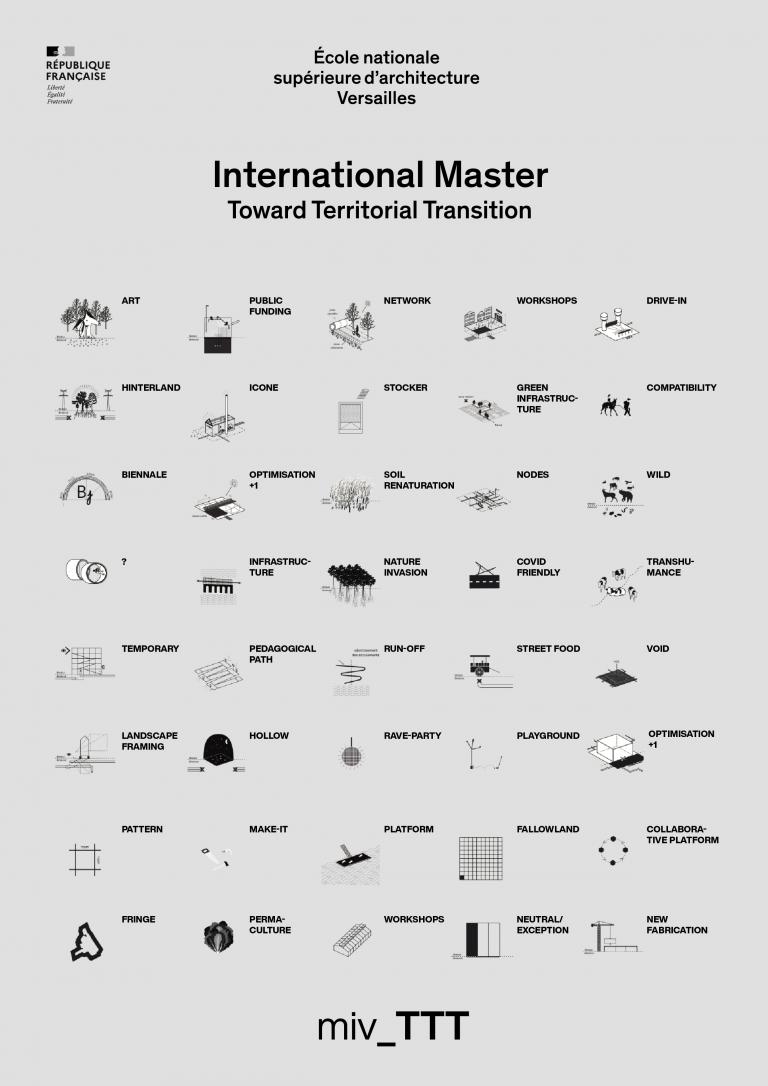International Master Toward Territorial Transition
(miv-TTT)
Entitled «Toward territorial transition», the international master focuses on the themes of metropolization and urban ecology, two main research and design axis of our school. Entirely in English and open to the disciplines and excellence of the ÉNSA Versailles and its partners, it is also original in its structure for its adaptability. The International master’s programme indeed welcomes diverse horizons students and offers great opportunities for mobilities and diplomas.

1/ French students involved in a French Chinese double master’s degree “Architect-Urbanist” with the famous CAUP-Tongji University in Shanghai.
2/ French students willing to seize diverse Erasmus or international program ex-changes opportunities. It is to note that students involved in the miv-TTT have preblocked ex-changes with our partners and the priority on ÉNSA Versailles’ exchanges compared to common cursus students.
3/ Chinese students in-volved in the French Chinese double master’s degree.
4/ International students welcomed at ÉNSA Versailles for one semester or one year. The French Chinese double master programme is limited to 12 students (6 French and 6 Chinese). The miv-TTT welcomes in total 20 students. For French students involved in the miv-TTT, after a selection based on Bachelor results, motivation and proficiency in English, the curriculum is organised into 2 to 3 years: first year at the ÉNSA Versailles, second year abroad (one full year or one semester depending on the cases), third year back to Versailles for the completion of a final diploma with a research mention (PFE mention recherche). During or in between second and third year, students are helped to find an international and/or research internship of minimum 3 months. As a result, students obtain: a French Architecture diploma with a research mention, and a double master “Architect-Urbanist” with the CAUP-Tongji for those involved in this specific miv-TTT option. It is to note that the development of other double master’s degrees as “Architect-Urbanist” and “Architect-Landscape architect” are in progress with our partners and new partnerships are explored.
The International Master’s program provides students tools and methods to answer significant and urgent contemporary questions such as:
- How to explore new ideas about city design, management, and planning to call for more radical thinking in the face of an environmental crisis?
- How to meet the colossal demographic and ecological challenges?
- How to question the idea of utopia and avoid dystopia?
- How to analyse territories and the systemic interrelations between nature, water, food, energy, pollution, and economy?
- How to acquire a theoretical urban culture, tackle the operational dimension of urban planning?
Reflection on these topics will enable students to learn how to interrogate a spatial context at different scales, to problematize an issue through an interdisciplinary approach, and at the same time to evaluate hypotheses for strategies. In addition, students will learn how to analyse numerous case studies of design material critically, how to spatialize complex systems, grasp their interoperability at different scales, and at the same time, design their temporal dynamics. Finally, the interweaving of knowledge and design experiments will enable students to create a personal connection and relationship between disciplines and work on various modes of representation to design and communicate their ideas. The analysis of territories is done by discovering different field sand tools that are new to the students and that they will find throughout the master’s degree and their double curriculum: geographic, statistical, cartographic, political, urbanistic... which are brought together in site portraits, with an effort at graphic transcription to bring them closer to the architectural demonstration.
More than a traditional educational program, students in the miv-TTT participate in international workshops, exhibitions, research, and publications regularly conducted. In addition, the publications and exhibitions about students’ works allow them to join a unique cultural environment and show their work and reflections to a broad audience. More than a traditional teaching method relationship, students benefit from the assistance of a dedicated tutor that helps in making training and career path decisions. In addition to this formal guidance, the school alumni network would ensure and generate solid backing for graduates during their studies and future working environments. More than traditional exchanges, students are offered opportunities to join international environments during their Master’s and to continue in those after graduation. Indeed, the program allows entering a unique network and partnerships with foreign universities and architecture, urbanism, and landscape agencies around the globe. In addition, the ÉNSA Versailles cross-national environment, which has hosted and is hosting scholars and teachers from all over the world, facilitates the richness of the exchanges’ proposition. Lastly, the educational and network offer will increase over the following years, offering students a broad spectrum of possibilities.